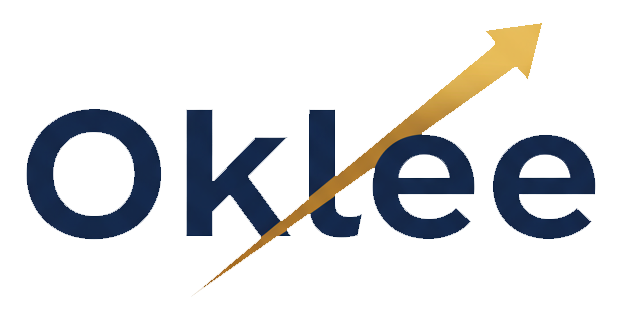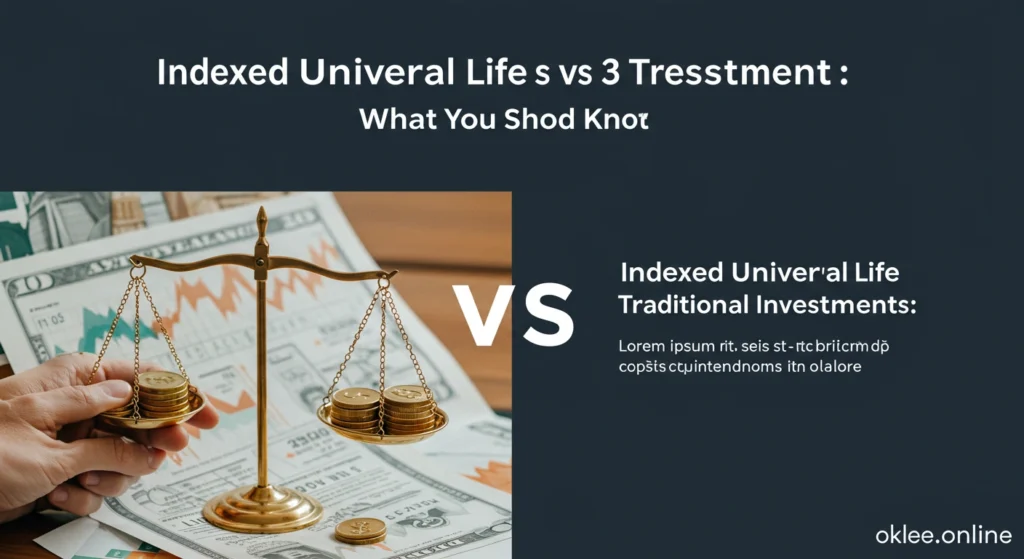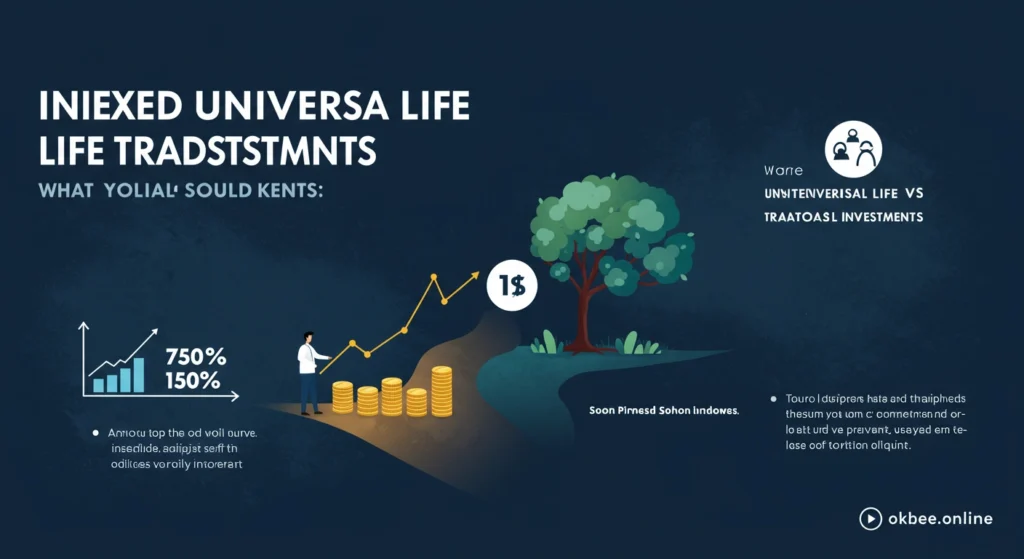Indexed Universal Life insurance (IUL) is often marketed as the “best of both worlds”—a way to grow your wealth tax-free while having life insurance coverage. But when you compare IUL vs stocks, ETFs, or real estate, it gets more complicated.
So, is IUL really a smart long-term financial tool? Or is it just a high-cost product dressed up as an investment?
In this post, we’ll break down the pros and cons of IUL compared to traditional investments, explain when it might make sense, and show you who should avoid it altogether.
What Is Indexed Universal Life (IUL) Insurance?
An Indexed Universal Life policy is a type of permanent life insurance that combines two elements:
- Death benefit (life insurance coverage)
- Cash value account that grows based on a stock market index (usually the S&P 500)
Your money isn’t directly invested in the market. Instead, your returns are tied to the performance of the index—with caps and floors. For example, if the index gains 12%, your policy might credit you 8%. If the index loses 10%, you’re credited 0% (no loss).
Sounds like a safe way to grow your money? Not quite. Let’s compare it to more common investment tools.
IUL vs Stocks
Stocks are the most straightforward and commonly used investment for long-term growth. You buy shares of a company, and you benefit if the share price goes up (plus any dividends).
Pros of Stocks:
- High potential returns over the long term (historically 8%–10% average annually)
- Liquidity – You can buy/sell anytime
- Simple to understand – No hidden fees or insurance riders
- Low cost – Especially if you use index funds or ETFs
Cons of Stocks:
- Volatility – Prices can swing a lot short-term
- Taxable gains – Unless held in tax-advantaged accounts
IUL Comparison:
| Feature | Stocks | IUL |
|---|---|---|
| Returns | High (market-based) | Moderate (capped index) |
| Risk | High | Low to moderate |
| Liquidity | High | Low – fees & penalties apply |
| Costs | Low | High (fees, insurance costs) |
| Tax Treatment | Taxed unless in IRA | Tax-deferred, tax-free loans |
| Transparency | High | Low – complex and layered |
Verdict: If you want long-term growth and control over your money, stocks are almost always a better investment than IUL. The only tradeoff is increased volatility.
IUL vs ETFs
ETFs (Exchange-Traded Funds) give you exposure to multiple stocks in a single investment. They’re one of the most efficient ways to diversify and build long-term wealth.
Pros of ETFs:
- Diversified – Spread across multiple assets
- Very low fees – Some as low as 0.03%
- Traded like stocks – Easy to buy/sell
- Tax-efficient if held in retirement accounts
IUL Comparison:
| Feature | ETFs | IUL |
|---|---|---|
| Risk/Reward | Moderate to high | Low to moderate |
| Growth Potential | High (market-driven) | Limited (capped returns) |
| Tax Treatment | Taxable unless in IRA | Tax-deferred, tax-free loans |
| Flexibility | High | Low |
| Fees | Extremely low | High |
| Use Case | Retirement, income | Legacy planning, tax shelter |
Verdict: ETFs are a better option for most investors—especially if you value flexibility, control, and low costs. IUL may offer tax-free withdrawals, but the fees eat into your returns.
IUL vs Real Estate
Real estate investing is another popular strategy for building long-term wealth and passive income. It also comes with its own risks and learning curve.
Pros of Real Estate:
- Appreciation and rental income
- Leverage – You can borrow to buy properties
- Tax advantages – Depreciation, 1031 exchanges, etc.
- Tangible asset
Cons:
- Requires large upfront capital
- Can be time-consuming – property management, repairs
- Market-dependent – Can drop in value
IUL Comparison:
| Feature | Real Estate | IUL |
|---|---|---|
| Income Potential | Moderate to high | Low |
| Liquidity | Low | Low |
| Tax Advantages | Strong (deductions) | Moderate (tax-free loans) |
| Risk | Moderate | Low |
| Hands-On Requirement | High | Low |
| Upfront Cost | High (down payments) | Moderate (premiums required) |
Verdict: Real estate offers better income potential and equity growth—but takes more work and money upfront. IUL is more hands-off, but with far lower returns.
So, Who Is IUL Actually Good For?
Despite the drawbacks, IUL isn’t completely useless. It can be a useful financial tool for:
✅ High-income earners who:
- Have maxed out 401(k) and Roth IRA contributions
- Need additional tax-deferred growth
- Want life insurance plus a low-risk cash value
✅ People doing estate planning:
- IUL can be used for tax-free wealth transfer
- Can help offset estate taxes or create a legacy
✅ Long-term planners:
- Willing to overfund policies for decades
- Can afford high premiums without needing liquidity
- Understand the policy structure and fees
But NOT ideal for:
- Young investors starting out
- People with limited income
- Anyone looking for short- to mid-term growth
- Those who don’t fully understand the product
Common IUL Sales Pitches to Be Careful About
Agents are often incentivized to sell IULs. That’s fine—but it means you need to watch for overpromises, like:
- “It’s a guaranteed income stream.” → It’s not. Cash value can collapse if underfunded.
- “You’ll earn market returns with no risk.” → Returns are capped, and fees reduce gains.
- “Tax-free retirement income.” → Only works if policy is well-funded and managed for decades.
Always request a realistic illustration, not just the best-case scenario.
Final Thoughts: IUL vs Traditional Investments
IUL offers some unique features—tax-free access to cash value, permanent insurance, and downside protection—but it comes with complex rules, high fees, and limited returns.
For most people, traditional investments like stocks, ETFs, and real estate are better long-term tools. They’re cheaper, more flexible, and proven over time.
That said, if you’re high-income, tax-optimized, and looking for estate benefits, IUL may deserve a small slice of your portfolio.
Summary Table: IUL vs Traditional Investments
| Investment Type | Return Potential | Fees | Tax Benefits | Liquidity | Best For |
|---|---|---|---|---|---|
| IUL | Moderate (capped) | High | Tax-free loans | Low | Legacy, tax shelter |
| Stocks | High | Low | Capital gains | High | Growth-focused investors |
| ETFs | High | Very low | Capital gains / tax-deferred | High | Long-term, passive investors |
| Real Estate | Moderate to high | Medium | Strong tax perks | Low | Hands-on income builders |
Want to dig deeper into IUL vs stocks for retirement planning?
Check out our next guide on “Roth IRA vs IUL: Which is Better for Tax-Free Growth?” or subscribe to our finance newsletter at oklee.online for weekly investment tips.




